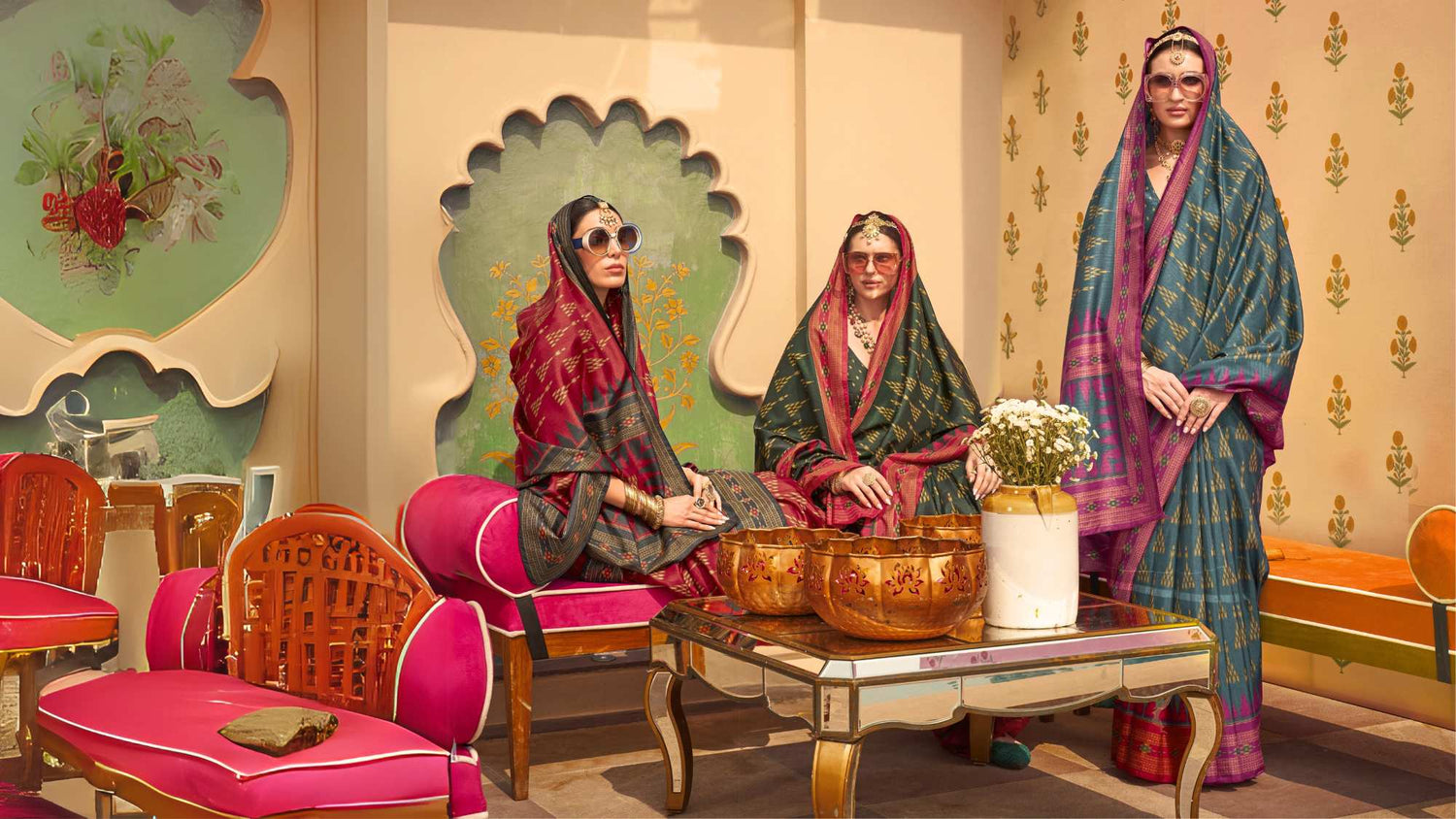Janmashtami, a vibrant Hindu festival celebrated with great joy across India and around the world, celebrates the birth of Lord Krishna, the eighth avatar of Lord Vishnu. As devotees involve themselves in the joyous festivities, one aspect that adds to the colourful varities of this celebration is the attire worn, particularly the elegant sarees that grace the occasion.
Among these, the choice of attire plays a significant role, especially for women who adorn themselves in beautiful sarees to mark the occasion. This season, we explore the seven best Janmashtami sarees from Sudathi that can make you stand out in the festivities.
Additionally, we'll explore the significance of specific colours traditionally worn on Janmashtami and highlight places where the festival is celebrated with extreme emotion.
Banaras-Banarasi Silk Saree
The richness of a Banarasi silk saree complements the ceremony of Janmashtami celebrations. The shades like red, maroon, or royal blue enhance the traditional vibe.
Patan-Patola Saree
The involved patterns and bright colours of Patola sarees express the festive joy of Janmashtami. Shades like red, yellow, and orange are popular choices for this occasion.
Kanchipuram-Kanjeevaram Saree
The rich heritage of Kanjeevaram sarees aligns beautifully with the cultural significance of Janmashtami. Choose colours like gold, orange, and peacock blue to reflect the festivity.

Bandhej-Bandhani Saree
The lively patterns and bright colours of Bandhani sarees capture the joyous spirit of Janmashtami. The colours like yellow, green, and pink symbolise happiness and prosperity.

Chit-ku-Pochampally Saree
The unique ikat designs and lively colours of Pochampally sarees make them a fitting choice for Janmashtami festivities. Colours like white with red or black borders can create a striking look.
Chanderi Saree
The fine shimmer and delicate designs of Chanderi sarees make them ideal for Janmashtami. Pastel shades like mint green, lavender, and soft pink add a contemporary touch to traditional attire.
Maharashtrian Paithani Saree
The ceremonial Paithani sarees make them perfect for the auspicious celebration of Janmashtami. Rich colours like magenta, royal blue, and emerald green enhance the festive spirit.
The Essential Part of Janmashtami Sarees
Sarees hold a special place in Indian culture, symbolising grace, tradition, and elegance. That is why Sudathi has come up with the budget friendly Janmashtami Collection which is affordable yet best quality guaranteed. During Janmashtami, women adorn themselves in well crafted sarees, reflecting the joy and devotion associated with the festival. The choice of sarees varies across different regions, with each style boasting its unique charm.
In North India, particularly in states like Uttar Pradesh and Rajasthan, women often choose for vibrant silk sarees embellished with mixed up embroidery or zari work. These sarees give off royalty and ceremonial, fit for the celebration of the birth of Lord Krishna, who is often portrayed wearing lavish attire.
In South India, especially in states like Tamil Nadu and Karnataka, women prefer traditional Kanjeevaram or Mysore silk sarees. These sarees are renowned for their rich colours, elaborate motifs, and glossy texture, symbolising prosperity and cultural heritage.
The Significance of Colors on Janmashtami
Colours play a significant role in Hindu festivals, symbolising various emotions, honour, and heavenly elements. When it comes to Janmashtami sarees, certain colours hold special moments, reflecting the soul of the occasion.
Blue
Blue is the spirit colour associated with Lord Krishna, body, divine nature, peace, and heavenly sensibility. It represents the vastness of the sky and the infinite potential within each individual. Many women choose blue sarees or sarees with blue accents to pay worship to Lord Krishna's divine appearance.
Yellow
Yellow indicates hopefulness, brightness, and joy. It represents the radiance of the sun, standing for enlightenment and spiritual awakening. Yellow sarees, adorned with golden motifs or borders, are popular choices during Janmashtami, reflecting the festive spirit and positiveness associated with the occasion.
Green
Green illustrates fertility, growth, and prosperity. It represents the flourishing plants, nature and the ever-renewing cycle of life. Green sarees, embellished with floral motifs or mixed up patterns, give rise to a sense of abundance and life, aligning with the themes of refresh and renewal celebrated during Janmashtami.
Red
Red signifies passion, devotion, and auspiciousness. It is associated with the divine feminine energy and the glowing power of transformation. Red sarees, adorned with gold embroidery or traditional motifs, are favoured by many women during Janmashtami, symbolising love, devotion, and reverence towards Lord Krishna.
While these colours hold special importance, it's essential to choose sarees that resonate with personal preferences and cultural traditions. Whether it's the dazzling blue of Lord Krishna's attire or the vibrant tint of nature, Janmashtami sarees serve as a beautiful expression of devotion and reverence.
Places Where Janmashtami is Celebrated with Extreme Passion
Janmashtami is celebrated with vast liveliness across India, but some places stand out for their grand festivities:
1) Mathura and Vrindavan, Uttar Pradesh:
2) Dwarka, Gujarat
3) Mumbai, Maharashtra
4) Udupi, Karnataka
5) Puri, Odisha
6) Gokul, Uttar Pradesh
7) Imphal, Manipur
Conclusion
Janmashtami is more than just a festival; it is a celebration of divine love, joy, and devotion. Adorning soul in a beautiful saree from Sudathi's Janmashtami Collection not only beautifies the festive spirit but also pays respect to the rich cultural heritage of India. Each saree style, from the luxurious Banarasi Silk to the vibrant Bandhani, offers a unique charm that repeats the heart of Janmashtami.
By choosing the right saree in the auspicious colours of blue, yellow, green, and red, you can hold the festival's message while expressing your personal style. As you join the celebrations in places like Mathura, Vrindavan, or Udupi, let your attire reflect the joyous and devotional spirit of Janmashtami.











